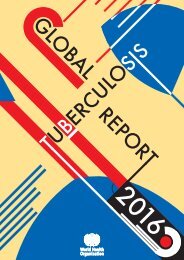patients
DNDi_AR_2015
DNDi_AR_2015
Create successful ePaper yourself
Turn your PDF publications into a flip-book with our unique Google optimized e-Paper software.
CHAGAS DISEASE<br />
R&D MODEL & PORTFOLIO<br />
The disease has two clinical phases, the acute phase (fatal for 2-8% of children), which is<br />
often asymptomatic or poorly symptomatic and unrecognized, and the chronic phase, which<br />
can be divided into two stages:<br />
• The chronic, asymptomatic (or indeterminate) stage, during which <strong>patients</strong> can transmit<br />
the parasite to others (mostly through blood, congenital transmission, or occasionally<br />
organ transplant) and which may last decades after infection.<br />
• The chronic, symptomatic stage, developing later in up to 30% of infected <strong>patients</strong>. Chagas<br />
disease causes abnormal dilation of the large intestine (megacolon), is the leading cause<br />
of infectious heart disease (cardiomyopathy) in the world, and the leading cause of death<br />
from a parasitic disease in Latin America.<br />
What are the current treatments and their limitations?<br />
Current treatments, benznidazole and nifurtimox, are effective against the acute phase of<br />
infection, and while there is increasing evidence of their efficacy in the chronic indeterminate<br />
phase of the disease, broad use of these drugs has been limited due to lack of guidelines<br />
and policies supporting implementation. Drawbacks include long treatment periods (60-90<br />
days), dose-dependent toxicity, and a high drop-out rate of <strong>patients</strong> due to side-effects.<br />
There is currently no approved treatment for the chronic form of the disease with target<br />
organ involvement (chronic symptomatic stage).<br />
Endemic in<br />
21 countries<br />
IN LATIN AMERICA<br />
70 million<br />
people at risk<br />
5.7 million<br />
people infected,<br />
leading to approximately<br />
7,000 deaths every year<br />
WHAT IS DNDi DOING TO ADDRESS UNMET TREATMENT NEEDS?<br />
DNDi’s short-term goal was to make<br />
better use of existing treatments, for<br />
example through the development of a<br />
paediatric dosage form of benznidazole<br />
– a goal which was achieved in 2011.<br />
The treatment is registered in Brazil by<br />
LAFEPE (2011), and was included on the<br />
WHO Essential Medicines List for children<br />
in 2013. An agreement signed in 2013 with<br />
the Mundo Sano Foundation ensures a<br />
second source of the paediatric dosage<br />
form to be produced by ELEA.<br />
Collaborative activities will continue to<br />
support country registration and adoption,<br />
and greater treatment availability to<br />
<strong>patients</strong>.<br />
As a medium-term strategy, DNDi has<br />
been assessing known families of<br />
compounds, such as nitroimidazoles and<br />
the new triazole antifungals, for activity<br />
against T. cruzi in adult chronic <strong>patients</strong>.<br />
A proof-of-concept trial showed<br />
fosravuconazole (E1224) monotherapy did<br />
not show sustained efficacy, as measured<br />
by sustained parasite clearance one year<br />
after end of treatment. In contrast, the<br />
current regimen of benznidazole was very<br />
efficacious over the period of 12 months of<br />
follow-up. Alternative benznidazole<br />
regimens, including reduced dosing and<br />
duration of treatment in monotherapy, and<br />
combination treatment with<br />
fosravuconazole, are now being explored.<br />
Fexinidazole, a non-genotoxic<br />
nitroimidazole currently in development<br />
for HAT and VL, is also being evaluated for<br />
treatment of adult indeterminate Chagas<br />
disease. Additionally, DNDi continues to<br />
search for potential biomarkers of<br />
treatment response to enhance clinical<br />
trial capabilities for evaluation of new<br />
compounds.<br />
As part of its long-term strategy, DNDi<br />
continues to identify and engage partners<br />
from private and public sectors in order to<br />
identify, characterize, and advance the<br />
development of promising compounds as<br />
well as to pursue discovery efforts for<br />
innovative therapies.<br />
In addition, DNDi supports clinical<br />
research capabilities and access through<br />
the Chagas Clinical Research Platform<br />
(see p. 60), which was launched in 2009.<br />
Ideally, a new treatment would target both<br />
acute and chronic phases of the disease,<br />
with activity against most parasite species<br />
in all endemic regions, with a better safety<br />
profile than existing drugs and noninferior<br />
efficacy to benznidazole, being<br />
easy-to-use (oral, once-a-day for less<br />
than 30 days, requiring no hospitalization,<br />
and little or no monitoring), affordable,<br />
and adapted to tropical climates.<br />
By 2020, DNDi aims to deliver<br />
from its Chagas-specific<br />
portfolio:<br />
• An effective, safe, new oral<br />
treatment regimen for<br />
chronic indeterminate<br />
Chagas disease, ideally also<br />
effective against the acute<br />
form of the disease<br />
• Biomarkers to gain<br />
understanding of disease<br />
progression and support<br />
evaluation of treatment<br />
response to support drug<br />
development<br />
DNDi Annual Report 2015 › 37



